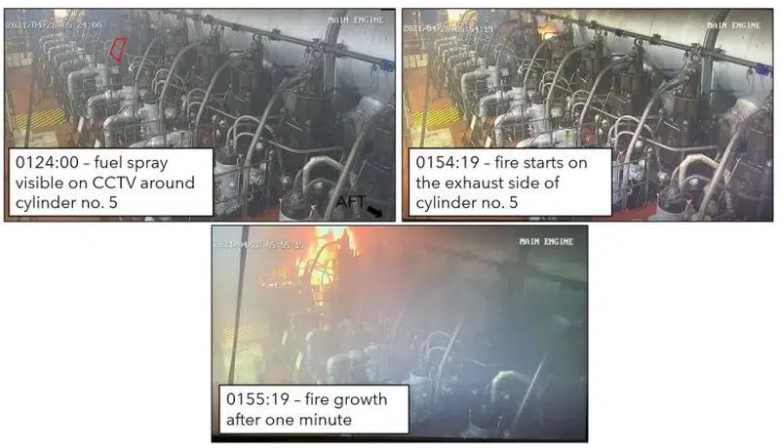发动机安装不当导致集装箱船起火
发表于 2022-05-25 18:55
美国国家运输安全委员会(National Transportation Safety Board)周二表示,由于主机燃油回油管安装不当,导致加利福尼亚州圣巴巴拉海岸外一艘集装箱船的机舱起火。
An incorrectly installed section of main engine fuel oil return tubing led to an engine room fire aboard a containership off the coast of Santa Barbara, California, the National Transportation Safety Board said Tuesday.
《海洋调查报告22/15》详细介绍了美国国家运输安全委员会对2021年4月28日集装箱船艾森豪威尔号在通过圣巴巴拉海峡时发生火灾的调查。这艘载有22名船员的船只正驶往加州奥克兰。机组人员使用机舱固定二氧化碳灭火系统灭火。
Marine Investigation Report 22/15 details the NTSB’s investigation of April 28, 2021, a fire aboard the containership President Eisenhower while transiting through the Santa Barbara Channel. The vessel was transiting to Oakland, California with a crew of 22. The crew extinguished the fire using the engine room’s fixed carbon dioxide fire-extinguishing system.
由于火灾,这艘船失去了动力,漂流了几个小时,然后被拖到洛杉矶港。没有污染或人员伤亡的报道。这艘船的损坏总额估计为822万美元。
As a result of the fire, the vessel lost propulsion and drifted for several hours before being towed to the Port of Los Angeles. No pollution or injuries were reported. Damage to the vessel totalled an estimated $8.22 million.
▲ (*** screen captures of the main engine showing fuel spray in the area around the no. 5 cylinder about 30 minutes before the fire, the moment the fire starts and the progression. Note: *** time stamps are four hours ahead. Source: APL)
4月28日凌晨,一名值班船员注意到浓烟从打开的机舱舱口冒出。两名船员身穿消防服,试图使用便携式灭火器灭火。船长意识到火势“太大”,决定向机舱排放二氧化碳。
A crewmember on watch noticed smoke coming from an open engine room hatch early in the morning on April 28. Two crewmembers donned firefighter outfits and attempted to use portable fire extinguishers to quell the fire. Realizing the fire was “too much,” the captain decided to release carbon dioxide into the engine room.
在船舶启航前一天,大管轮为主机安装了一段新的钢制燃油回油管。火灾后检查表明,新安装的燃油回油管末端的压缩连接件断开,导致超低硫柴油燃油燃烧喷射。船上的闭路电视画面显示,在起火前大约30分钟,柴油喷了出来。火灾发生后不到一分钟,存放在主机上方一层甲板上,靠近辅助锅炉旁边的纸板箱和木箱备件就着火了。
The day before the vessel’s departure, the second engineer installed a new section of steel fuel oil return tubing for the main engine. A post fire examination showed that a compression fitting on the end of the newly installed section of fuel return tubing had disconnected, causing the ultra-low sulfur diesel fuel oil the engine was burning to spray. *** footage from the vessel showed diesel oil spray about 30 minutes before the fire started. Within one minute after the fire started, cardboard and wooden boxes of spare parts, which were stored one deck above the main engine and next to the auxiliary boiler, caught on fire.
调查人员发现,一个未屏蔽和未绝缘的排气阀补偿器法兰作为喷射柴油的点火源。对断开的燃油回油管和失效的压缩管件的检查显示,压缩管件的密封套圈没有充分地嵌入到钢管上。
Investigators found that an unshielded and uninsulated exhaust valve compensator flange acted as an ignition source for the spraying diesel fuel. An examination of the disconnected fuel oil return tubing and failed compression fitting revealed that the compression fitting’s sealing ferrule was not sufficiently swaged to the steel tubing.
美国国家运输安全委员会(NTSB)认定,集装箱船机舱起火的可能原因是艾森豪威尔总统号的一名船员在安装主发动机气缸的燃油回油管时,未充分锻造压接套圈,从而使油管的一端断开,并将燃油喷射到附近的非屏蔽和非绝缘气缸排气部件上。
The NTSB determined the probable cause of the engine room fire aboard the containership President Eisenhower was a crewmember insufficiently swaging a compression fitting ferrule during the installation of fuel oil return tubing for a main engine’s cylinder, allowing an end of the tubing to disconnect and spray fuel oil onto a nearby unshielded and uninsulated cylinder exhaust component.
国家运输安全委员会从这次调查中总结了两个经验教训:
NTSB identified two lessons learned from this investigation:
1. 快速油泄漏检测系统是一种有价值的工具,可用于防止机舱火灾。视频分析技术旨在使用标准的***视频来实时检测燃油雾和喷雾,并在任何点火和火灾前向机组人员发出警报。
1. Rapid oil leak detection systems are a valuable tool that can be used to prevent fire in machinery spaces. Video analytic technology is designed to use standard *** video to detect fuel mist and spray in real time and alert the crew before any ignition and fire.
2. 艾森豪威尔总统号的机组人员通过清除燃料和氧气源、冷却边界和有效的沟通,有效地控制了主机舱火灾的蔓延。这表明了基于现实场景的培训的重要性,包括包括关闭机器、燃油、润滑油和通风系统以及边界监测在内的机舱紧急情况培训,以迅速遏制和扑灭机舱火灾。这可能会扩散到其他空间和/或导致动力和电力的损失。
2. The crew of the President Eisenhower effectively contained the spread of a main engine room fire by removing fuel and oxygen sources, cooling boundaries, and communicating effectively. This shows the importance of realistic scenario-based training, including engine room emergencies, which involve shutting down machinery, fuel oil, lube oil, and ventilation systems, as well as boundary monitoring, to quickly contain and suppress engine room fires, which can spread to other spaces and/or cause a loss of propulsion and electrical power.
免责申明:本文来自ntsb,仅代表作者观点,不代表中国海员之家立场。其真实性及原创性未能得到中国海员之家证实,在此感谢原作者的辛苦创作,如转载涉及版权等问题,请作者与我们联系,我们将在第一时间处理,谢谢!联系邮箱:cnisu@54seaman.com


 联系我们人工客服
联系我们人工客服



















 :1391995811
:1391995811


评论 (0人参与)